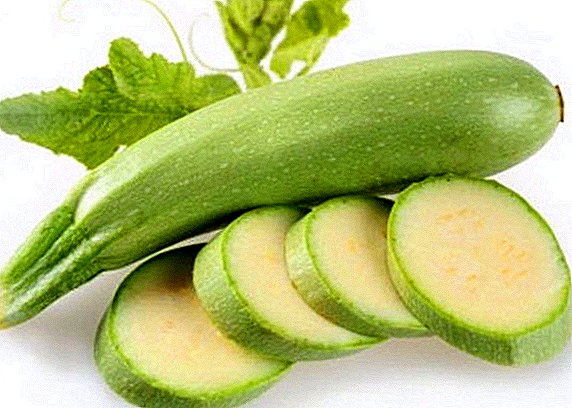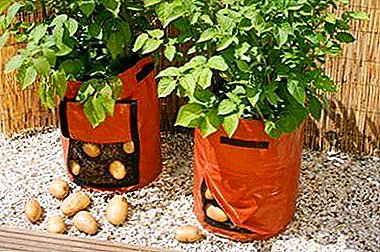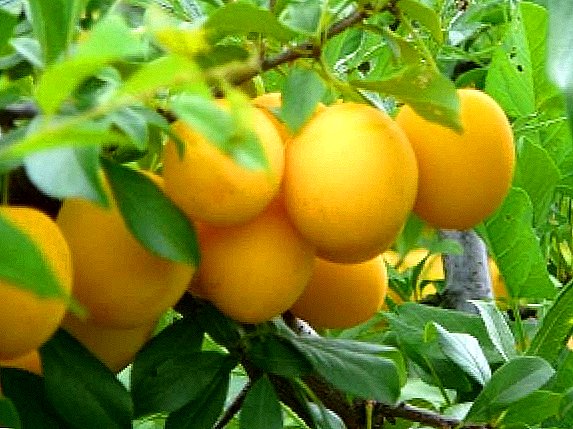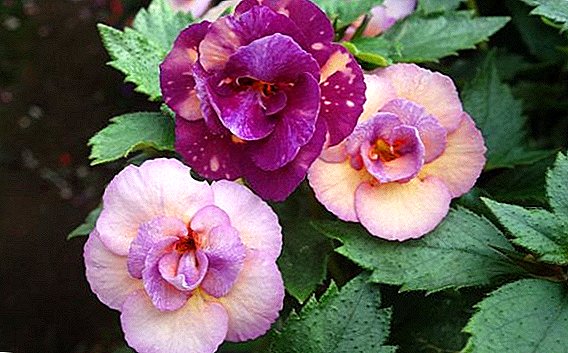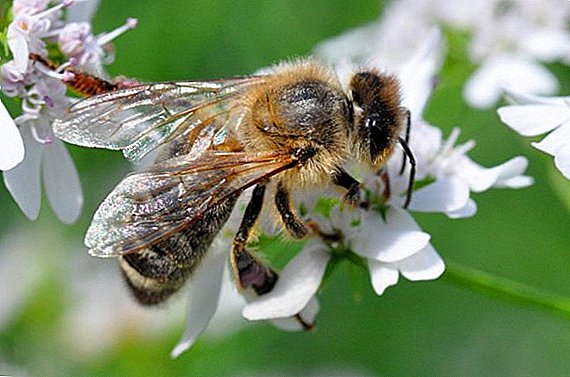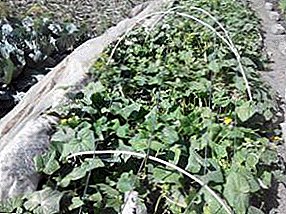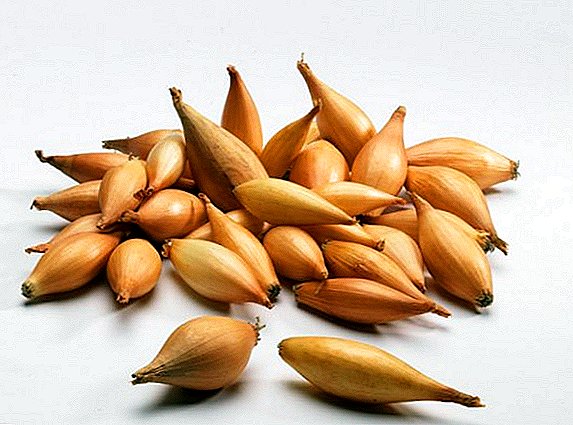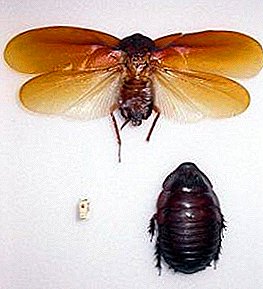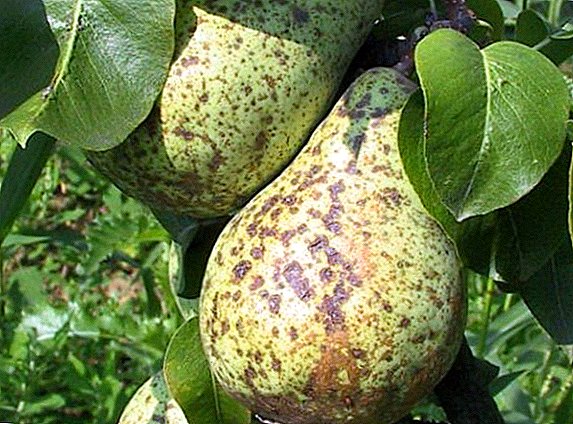 The goal of all gardeners is a rich harvest of fruits. However, to grow it you need to constantly take care of fruit trees, to engage in the prevention and treatment of diseases. And the dangers that await trees are numerous. A pear can strike several ailments. After reading this article, you will learn about the most frequent diseases of the pear, about the methods of their prevention and treatment.
The goal of all gardeners is a rich harvest of fruits. However, to grow it you need to constantly take care of fruit trees, to engage in the prevention and treatment of diseases. And the dangers that await trees are numerous. A pear can strike several ailments. After reading this article, you will learn about the most frequent diseases of the pear, about the methods of their prevention and treatment.
Bacterial burn
Have you ever noticed dark brown or black lesions on the foliage, branches and trunks of your trees? These are signs of an infectious disease called bacterial burn. It often affects fruit plants. The bacteria Erwinia amylovora provoke the disease, they are spread by insects, wind, rain.
Did you know? Cases of a bacterial burn have been documented in the 18th century. And now, for two and a half centuries, this disease has caused great inconvenience to gardeners around the world.Bacterial pear burn is very dangerous. It can spread to healthy trees at lightning speed and even lead to the saddest consequences - the final destruction of the garden. Therefore, it is necessary to begin to fight the burn already at the initial stage.
 Treatment. When the disease is detected at the initial stage, the affected branches should be removed, and the cut should be processed with 1% copper sulphate solution (100 g per 10 l of water) or 0.7% iron sulphate (70 g per 10 water). Effective also is the treatment of 5% solution of "Azofos", antibiotics: chloramphenicol, rifampicin, streptomycin, gentamicin, nalidixic acid and kanamycin in a dosage of 1-2 tablets / ampoules per 5 liters of water (enough for 8-10 trees). Trees are best processed in May and June. With the appearance of inflorescences and during flowering, treatment with 1% Bordeaux liquid can also be effective. In case of significant damage, sick pears and trees at a distance of 5 m are recommended to be uprooted and burned.
Treatment. When the disease is detected at the initial stage, the affected branches should be removed, and the cut should be processed with 1% copper sulphate solution (100 g per 10 l of water) or 0.7% iron sulphate (70 g per 10 water). Effective also is the treatment of 5% solution of "Azofos", antibiotics: chloramphenicol, rifampicin, streptomycin, gentamicin, nalidixic acid and kanamycin in a dosage of 1-2 tablets / ampoules per 5 liters of water (enough for 8-10 trees). Trees are best processed in May and June. With the appearance of inflorescences and during flowering, treatment with 1% Bordeaux liquid can also be effective. In case of significant damage, sick pears and trees at a distance of 5 m are recommended to be uprooted and burned.
Important! Such types of pears as Lykashovka, Conference, Favorite, Bere Gardi most often fall ill with a bacterial burn. The Moscow, January and Muratov pears have shown themselves to be the most persistent.
Brown spot
 The first signs of damage to your trees with brown spot can be observed in late spring - early summer. The leaves are covered with brown spots. Their number is rapidly increasing every day, and soon the whole leaf turns brown and then falls. Massively infected pears in July and August. Treatment. If this disease is detected in trees, fallen leaves should be carefully removed. Since this is a fungal disease, the treatment must be carried out with antifungal agents - copper fungicides in the composition. At the same time note that the spraying should be stopped immediately after the start of growth of the fruit.
The first signs of damage to your trees with brown spot can be observed in late spring - early summer. The leaves are covered with brown spots. Their number is rapidly increasing every day, and soon the whole leaf turns brown and then falls. Massively infected pears in July and August. Treatment. If this disease is detected in trees, fallen leaves should be carefully removed. Since this is a fungal disease, the treatment must be carried out with antifungal agents - copper fungicides in the composition. At the same time note that the spraying should be stopped immediately after the start of growth of the fruit.
Important! To defeat brown spot resistant Bere, Kure, Ardanion, Clapp.
Scab
Often pears have a disease called scab. The scab pathogen, the fungus Fusicladium pirinum, infects fruits, leaves, and shoots. The main symptoms of the disease: olive-colored spots with a velvety coating on the underside of the leaf, falling leaves, cracking fruits and hardening of their pulp. On the fruits, dark lesions with a bright rim and brown patina become visible. The pear is covered with cracks, the fruit is deformed, acquires an irregular, asymmetrical shape.  Treatment. If the scab infects young shoots, the only way to combat the sore is to remove them. It is recommended to treat with 1% Bordeaux mixture, copper oxide in three stages: the first - in the period of the appearance of buds; the second - immediately after flowering; the third is 15 days after the second.
Treatment. If the scab infects young shoots, the only way to combat the sore is to remove them. It is recommended to treat with 1% Bordeaux mixture, copper oxide in three stages: the first - in the period of the appearance of buds; the second - immediately after flowering; the third is 15 days after the second.
Important! Resistant to scab Muratovskaya, Rusanovskaya, Yanvarskaya pear.
Fruit Rot (Moniliasis)
If your attention was attracted by brown spots on pear fruits, then most likely, Monilia fructigena mushroom snuck into your garden, which causes fruit rot or pear moniliosis. The disease develops rapidly - in a week the fetus can become completely brown. Later on the fruits can be observed white outgrowths. The flesh becomes loose and tasteless. Sick pears fall, some can dry out and stay on the branches up to two years. If the disease is not treated in time, then it will provoke growths on pear branches. The spread of rot occurs from mid-July to August, especially during hot and humid summers.  Treatment. Sick fruits and branches must be destroyed. The cutting of branches is necessary to produce both in spring and in autumn. Recommended spraying of pears with fungicides and strengthening their immunity with the help of basal dressing from bioktayl ("Actofit", "Ecoberin", "Healthy Garden", "Baikal").
Treatment. Sick fruits and branches must be destroyed. The cutting of branches is necessary to produce both in spring and in autumn. Recommended spraying of pears with fungicides and strengthening their immunity with the help of basal dressing from bioktayl ("Actofit", "Ecoberin", "Healthy Garden", "Baikal").
Important! High immunity to moniliosis in pears of Cheremshin, Autumn dream, Honey. Fully resistant to fruit rot has not yet been bred.
Mosaic disease
Mosaic disease is most dangerous for pears. The characteristic symptoms are angular light yellow or pale green spots on young leaves. It is possible to infect a tree with a virus during grafting.
Treatment. Unfortunately, this disease is not curable. Saplings and trees can no longer be helped. They need to be burned so that the virus does not move to the trees growing nearby.
Black fungus
Black fungus is a type of disease of the leaves and shoots of pear, in which the foliage is covered with a black, soot-like plaque.  Treatment. Spraying the trees with a copper-soap solution (5 g of copper sulphate and 150 g of soap per 10 liters of water), with a solution of Bordeaux mixture or copper oxychloride. Fully protected from black fungus, only one type of pear - the Cathedral.
Treatment. Spraying the trees with a copper-soap solution (5 g of copper sulphate and 150 g of soap per 10 liters of water), with a solution of Bordeaux mixture or copper oxychloride. Fully protected from black fungus, only one type of pear - the Cathedral.
Mealy dew
A characteristic sign of the defeat of a pear with powdery mildew is a grayish-whitish coating on the foliage and buds, which gradually becomes red. Over time, the leaves are folded into the boat. Powdery mildew attacks only young plants, so the onset of the disease occurs during the period from budding to the appearance of the first leaflets. The disease is spread by the parasitic fungus Erysiphales.  Treatment. For powdery mildew, antibiotic treatment is effective: terramycin, penicillin and streptomycin in a 1: 1 ratio. Also gardeners with experience recommend processing a mixture of soda ash (50 g) with liquid soap (10 g) in 10 liters of water or spraying with 1% solution of potassium permanganate.
Treatment. For powdery mildew, antibiotic treatment is effective: terramycin, penicillin and streptomycin in a 1: 1 ratio. Also gardeners with experience recommend processing a mixture of soda ash (50 g) with liquid soap (10 g) in 10 liters of water or spraying with 1% solution of potassium permanganate.
Important! Muscovite, Duhmyanaya and January pears are famous for their resistant powdery mildew immunity.
Rust
Already from the very name of this disease, it can be understood that its main symptoms are dark orange (rusty) spots on the leaves and fruits that occur in early summer. Later, in August, it is possible to observe conical (in the form of papillae) growths on the leaves of the pear, striking their underside. The causative agent of the disease is the fungus-parasite Gymnosporangium sabinae. With a strong infection with rust, both leaves and fruits are covered, and shoots. At the same time, the pear's immunity decreases and the general condition worsens. Sometimes a tree that has had a disease stops producing fruit.  Treatment. For the treatment of rust on pear and apple need to dispose of diseased leaves and fruits. Gardeners claim that in order to prevent the penetration of this disease into the garden, spraying with a solution of urea, blue vitriol, infusions of ashes, marigolds, and horsetail have well proved themselves. Treating trees should be recommended to your neighbors. If the disease has already affected your plantings, then there is no better way than to process pears in early spring with a 1% solution of Bordeaux mixture, no.
Treatment. For the treatment of rust on pear and apple need to dispose of diseased leaves and fruits. Gardeners claim that in order to prevent the penetration of this disease into the garden, spraying with a solution of urea, blue vitriol, infusions of ashes, marigolds, and horsetail have well proved themselves. Treating trees should be recommended to your neighbors. If the disease has already affected your plantings, then there is no better way than to process pears in early spring with a 1% solution of Bordeaux mixture, no.
All types of pears can get rusty.
Root cancer
Root cancer is found in young plants. It is caused by the bacterium Agrobacterium tumefaciens. Solid woody growths of various sizes are formed on the roots and root neck of the seedlings. In the case of disembarking diseased seedlings, bacteria that cause root cancer can live in the soil for several years.  Treatment. Before planting the seedlings they need to be carefully diagnosed and removed infected with root cancer. Small growths on the lateral roots must be cut off, the roots are sanitized for 5 minutes in a 1% solution of copper sulphate.
Treatment. Before planting the seedlings they need to be carefully diagnosed and removed infected with root cancer. Small growths on the lateral roots must be cut off, the roots are sanitized for 5 minutes in a 1% solution of copper sulphate.
Important! Most stable to root cancer grade - Lemon.
Black pear crab
 Black cancer affects the bark of the trunk, skeletal branches and fruits. First, small cracks or wounds form on the cortex, which further increase, which provokes breaks in the cortex. Spots of bright-brown color appear around the wounds.
Black cancer affects the bark of the trunk, skeletal branches and fruits. First, small cracks or wounds form on the cortex, which further increase, which provokes breaks in the cortex. Spots of bright-brown color appear around the wounds.
Treatment. For the prevention of the appearance of cancer of pear, fallen leaves are carefully removed and burned. Infected fruits and bark areas are removed, fresh wounds are smeared with copper sulphate, clay with mullein or special lubricants. Inhibit the development of black cancer and fungicides.
Important! High immunity to Antonov fire is observed in pear varieties Avgustovskaya dew and Samaritan.
Cytosporosis
The cause of cytosporosis pears can be freezing and sunburn. In cytosporosis, the bark of the pear turns red-brown and dries out. On the diseased areas, tubercles are formed - an accumulation of the causative agent: the fungus Cytospora leucostoma.  Treatment. The recipe for treating pear cytosporosis is identical with the treatment methods for black cancer. This disease should not be afraid of the owners of Muscovites and the January Pear.
Treatment. The recipe for treating pear cytosporosis is identical with the treatment methods for black cancer. This disease should not be afraid of the owners of Muscovites and the January Pear.
Cracks in the bark
Are there any cracks in the bark of your pear? The reasons for this can be many - this is a sharp temperature drop (freezers, sunburns), and too deep planting of trees in the soil, and unsuccessful pruning, and excessive and untimely use of fertilizers.
The effects of cracking trees are slower growth, shrinking and premature fall of fruits and leaves. However, the cracks themselves on the bark of pears are not as dangerous as the complication that arises on their background: infection of wounds with viruses, bacteria, spores of pathogenic fungi, the appearance of rot.
 Treatment. Cracks can not be ignored, they must be treated. To begin, clean the damaged bark to a healthy tissue with a metal brush or cut it off with a knife. Then the crack should be treated with 1% or 3% Bordeaux liquid or any antifungal agent. A 3% solution of ferrous sulfate will also work. Cracked crack cover with clay, mullein or special putty.
Treatment. Cracks can not be ignored, they must be treated. To begin, clean the damaged bark to a healthy tissue with a metal brush or cut it off with a knife. Then the crack should be treated with 1% or 3% Bordeaux liquid or any antifungal agent. A 3% solution of ferrous sulfate will also work. Cracked crack cover with clay, mullein or special putty.
Did you know? In the people of the disease with such a terrible name is also known under the name "Anton fire" or "fire." They began to call him that because the stricken garden looks like a conflagration, the trees look charred.
Pear Disease Prevention
As in the case of human diseases, the main point for maintaining normal growth and fruiting of pears is the struggle not with consequences, i.e. treatment, and disease prevention. The sooner you start prevention, the more likely you are to harvest a good fruit crop.
To preventive measures to avoid the main ailments of pears include:
- timely destruction (cleaning and burning) of fallen leaves;
- thinning thickened crowns;
- treatment of basal soil plots;
- prophylactic 4-5-fold spraying with 1% Bordeaux liquid, 0.3% suspension of 90% copper oxychloride, 1% suspension of colloidal sulfur;
- planting resistant varieties of disease in your region.


